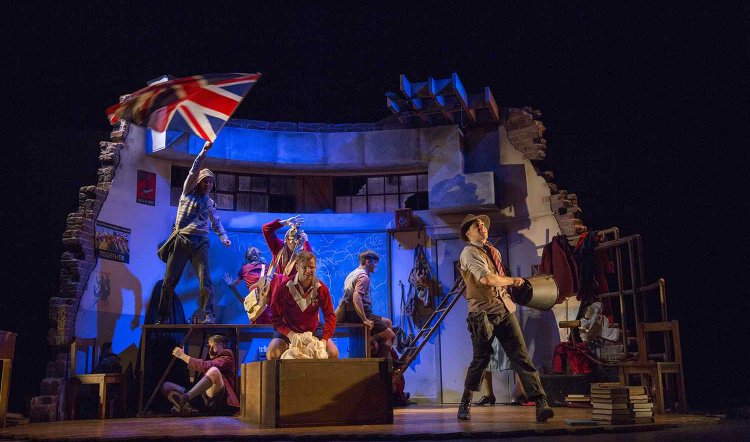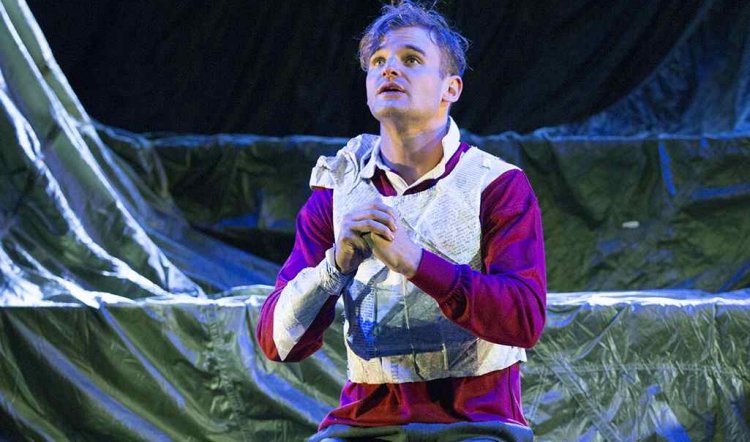
HENRY V
HENRY V, Bell Shakespeare Company at the Playhouse Theatre, Sydney Opera House; 23 October-14 November 2014. Photography by Michele Mossop: above - the company; right: Michael Sheasby.
Some readers will know of my preoccupation with the imperative of having an apparently great idea immediately followed by someone asking “okay, and then what?” All successful creative endeavours are the result of satisfactorily answering that question. All failed creative endeavours are the result of (a) not asking the question or, (b) ignoring the answer, which was “um…not sure, haven’t worked it out yet” and carrying on regardless.
The STC’s recent Macbeth was an excruciating example of the likely outcome of (b). On the other hand, this Henry V is the best possible evidence of the question being asked and answered and worked out before anyone went anywhere near a rehearsal room.
That being said, it seems reasonable to state that Damien Ryan is the most remarkable realiser of Shakespeare currently working in this country. His touring production of Henry V, devised for Bell Shakespeare and lately arrived in Sydney, simply underlines that fact.
Ryan begins with two ideas and seamlessly brings them together and to fruition. First of all, in his director’s notes, he tells of being inspired by reading of how some coped with the unimaginable terror of the Blitz by assembling makeshift reading libraries, others by storytelling and others by making theatre in the underground shelters where thousands spent long, sleepless nights. And specifically of how a group of students formed “The Boys’ Club” to stage plays and cabarets in an effort to keep fear and panic at bay and pass the dragging hours, night after night, as the Luftwaffe bombed and bombed and bombed the fabric but not the heart out of London.
He’s then assembled a youthful company of actors who credibly assume high school personas cajoled and led by their school master (sole mature-age actor Keith Agius). They start with a précis of Richard II and Henry IV to set the scene and explain Henry V’s brutal war with France. And it’s in these early scenes that we’re handily reminded of the youthfulness of the king and his court as well as the general terror of life in the 1400s.
Henry V died at 34 or 35; he had led his army into the battle of Agincourt – central to the play and his great and bloody triumph - at the age of 29 or 30. (Born insignificant, his year of birth was never recorded.) Few of his courtiers and friends were older - his father died at 46 - so to have these people played by young actors and teenage students brings into sharp and startling focus a reality for both that’s almost beyond our understanding.
Although neither he nor anyone else then living in England and France knew it, they were taking part in what we now know as the Hundred Years War. That is, none knew a state of mind and being other than degrees of conflict and fear. The kids and people of the Blitz were in a similar situation. When WW2 began it was supposed to be over in six months, yet had already been going on for two years by the time Hitler ordered the unrelenting bombing of the blitzkrieg (a nightmare that lasted eight months) and peace would not be declared for another four years after that.
Somehow, Ryan has managed to convey both the immediacy of particularly barbaric war (the Blitz specifically targeted civilians; Henry’s army massacred their helpless opponents and then stood back as French women and children starved) and also the mindless, giggling fright that must surely have been part of not knowing the outcome nor when it would be over. It’s something that we can barely begin to grasp yet is central to any understanding of life in (protracted) wartime.

Michael Sheasby is a clear-eyed, handsomely boyish Henry, straight out of Tom Brown’s Schooldays and Boy’s Own heroics. He is a sweet presence at the centre of both the school kids’ boisterous fun and the exuberant privilege of the young nobles. He shifts worlds from callow to feckless and is effectively accompanied by the dubious Pistol (Damien Strouthos) Bardolph (Darcy Brown) and Mistress Quickly (Danielle King) before moving on to kingly maturity. Agius who doubles as the avuncular drunk-mentor Falstaff is the foil to this endeavour as the rest of the company double and treble roles with deceptive ease. Drew Livingstone is more Delhi than Cardiff as the Welshman Fluellen but nevertheless is a solid anchor as well as source of verbal fun, while Gabriel Fancourt as Boy keeps the audience directly in touch with the action.
On the other side is the deeply shallow Frogginess of Ildiko Susany as the governor of Honfleur and Matthew Backer as the Dauphin; Then, by way of contrast, there’s a wittily attractive Eloise Winestock as Catherine of Valois. Crucially, in the context of Shakespeare’s play, it’s easy to see why Henry actually fell for her even though the reasons for marrying were entirely political. And it’s also worth remembering that Catherine was 19 when they married and was pregnant with their son when Henry died, just two years later. (Side note: she lived to the ripe old age of 36 and died after giving birth to the last of a half dozen children to Owen Tudor and inadvertently, to the Tudor dynasty.)
If all this sounds like a history lesson it may be because the production so entertainingly yet profoundly conjures the images of both history and the classroom. The bomb shelter set (design of set and costumes: Anna Gardiner) is a character in itself: a crumbling brick ruin furnished with free-standing shelf units that double and treble as energetically as the rest of the cast (you want a ship? battlefield trenches? a mountain? an obstacle course of a bombed out village? no worries). In the second half, a silky green parachute conceals and reveals by turn as it’s manipulated in fluttering billows by members of the cast to become whatever and wherever is necessary. So simple, so effective. The lighting is equally so.
Designed by Sian James-Holland, who utilises everything from a single wan beam, to Klieg-style dazzle, to multiple torches to the frequent and frightening effects of night-time bombs and fires. Head of costume, Renata Beslik has fashioned armour and regal accoutrements from newspaper and scraps of fabric; these are worn over classic school uniforms - striped ties, grey flannel shorts, shapeless shifts for the girls - and weaponry that is poignantly reminiscent of the playground. (A ceiling fan blade is wielded as a sword while Henry’s kingly blade is two scraps of wood.)
The ensemble is constantly moving in tightly choreographed tableaux through night-time story-telling into battles, aftermath, political machination and more battles, making movement director Scott Witt an unseen but vital member of the cast. So too Steve Francis whose sound design and execution is incisive, intelligent and exciting.
The most exhilarating things about this Henry V, however, are the clarity and simplicity of its conception and execution. That means whichever way you look at it – wartime London or wartime Agincourt – the drama, pathos, laughter and ultimate tragedy are dazzlingly transparent and heart stopping. It is impossible not to be swept up and away by the sadness and hilarity that epitomises the essence of youth and the enthusiastic barbarism of war. The king is dead – long live the king.



